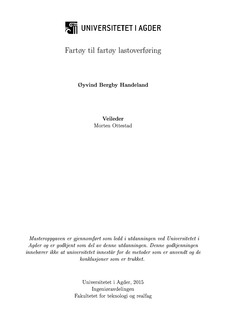| dc.description.abstract | In the o shore industry there is a need to compensate motions caused by waves and wind. It is important if
loading is to be transferred from one vessel to another in a safe and e cient manner. To make this happend,
the relative movement between the two vessels must be measured. A common way for doing this is to use a
MRU (Motion Reference unit). This measures the orientation of boat related to world coordinates.
This assignement is based on a scenario where two vessels are in motion related to the world coordinate system
asynchronously relative to each other. A MRU on one of the vessels will not be able to measure this movement
on it's own, but must be connected to a common control system along with a MRU on the second vessel. Linking
two vessels together with a physical wire is neither safe or convenient.
As a substitute for the MRU system it was made a passive vision system for measuring the relative movement.
The system operates by having a camera attached to one of the vessels, and a pattern in the form of a chessboard
to a plan surface on the other vessel. The camera acquires images of the familiar pattern. The image processing
and homography is used in LabVIEW to calculate the relative pose between the camera and the plan surface.
It is shown that this system is operating correctly, but the measurements are vulnerable to noise and small
changes in the ambient light. For this assignement the problem statement has been to create a vision system
that is more robust for changes in light conditions and noise.
Two new vission systems were made for this master thesis. One of them is a passive vision system that incorporates
much of the same theory that the previously developed system. The pattern which is analyzed in the new
system is concentric contrasting Circles(CCC). The second is an active vision system where four laser pointers
projecting a pattern is analyzed. The latter system is using trigonometry to calculate the heave, roll and pitch.
For testing the systems, it was built a platform with the 4 lasers and a camera centered in the middle. Static
tests were conducted for the three vision systems using this platform.
The noise were de ned using standard deviation. A circle with a diameter of 40mm had a noise level about
24% relative to a corner. The noise level of a laser dot was measured to 140% relative to a corner. The results
indicated that the circle is most robust with respect to noise.
The 3 systems were tested with 5 di erent light intensities. The corner system managed to calculate the pose
for 1 of the 5 lighting conditions. When the lightning conditions became too dark or too bright, this system
failed to calculate the pose. The system analyzing concentric circles calculated pose for the 4 brightest lightning
conditions, and the laser system for the 3 darkest lighting conditions.
Together, the two new systems will cover all of the 5 lightning conditions that have been tested, and they will
also overlap in two of them. It will then be possible to get a complementary system by merging these two
systems. The complementary system will be able to measure results for all of the 5 lighting conditions, and be
redundant for the conditions overlapping. For this system the most convenient pattern to be analyzed must be
desided at any given time. This can be determined by measuring the average grayscale value in the image up
against two thresholds. In case the average grayscale value is smaller than the smallest threshold, the lazer dots
will be analyzed. In case it is larger, both the patterns are analyzed. For an average grayscale value larger then
the largest threshold, only the circles are analyzed. | nb_NO |
